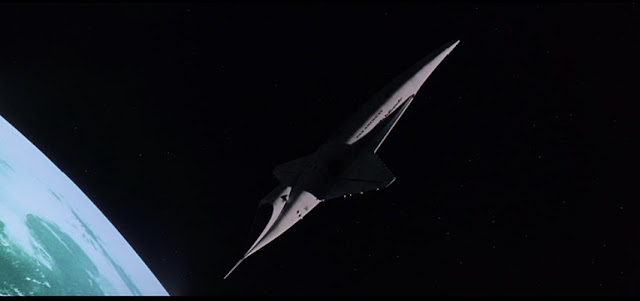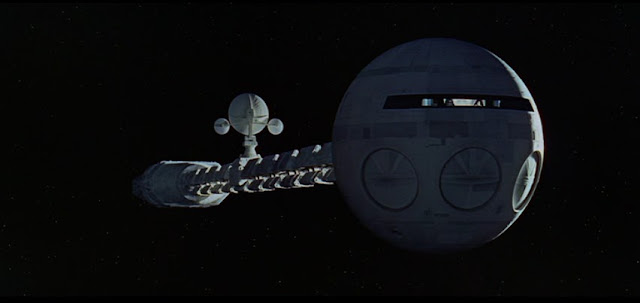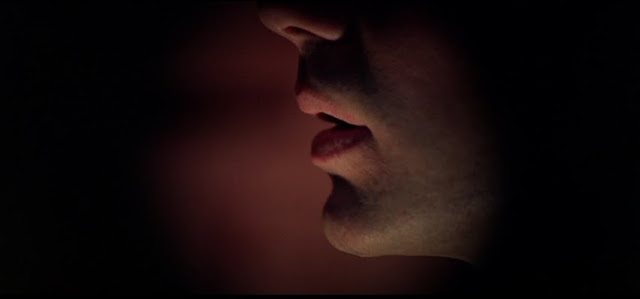



Top left: Early in the movie, with Danny and his mother home alone together in the Torrance apartment in Boulder, Colorado (near Denver), Danny converses with 'Tony' while in the apartment's bathroom. Note that Danny is using his left index finger to represent Tony; Carl Jung indicates that the left represents the unconscious mind (and that the right represents the conscious).[a] Tony not only says that he doesn't want to go to the Overlook, since he 'knows' that he (Danny) is to continue to be sexually abused there, but he also here refers to Wendy by her first name while speaking, suggesting an inappropriate level of familiarity between Danny and his mom. Top right: The next thing we see is a (boiling) 'river' of blood, representing, in part, Wendy's menstrual blood. Wendy is menstruating while having sex with Danny. Above left: Danny's facial expression while being sexually abused by his mom, indicates that he is in a trance state during the episode. Above right: A short while later, Wendy has called a doctor to come over and speak with Danny. Note that the doctor doesn't question Wendy as to why Danny's pants are off. It's not as if the doctor herself would have him remove them, in order to examine him for psychiatric or neurological problems. It is evident from the doctor's conversation with Danny that she is completely overlooking the possibility that Wendy has just sexually abused him. Although what we see here is part of Susan Robertson's dream (as is everything else in the movie), the scene represents a real-life event, whereby the woman in the red VW that Susan was riding in had abused her own son while with him in an apartment in Boulder; this woman later told Susan about the abuse incident, while she and her family were with Susan in the snowstorm, at the crash site.

Note the bear face that is part of Danny's pillow (above left), on his bed while the doctor is examining him. At a later point in the movie, Wendy tells Dick Hallorann that her first name is Winifred, and Hallorann responds by asking her if she is a Winnie or a Freddie. Winnie-the-Pooh is a fictional anthropomorphic teddy bear created in the early 20th century by English author A. A. Milne, that is a character in various children's books. The point is that Wendy is being connected with a kind of bear 'theme' in the movie. The eyes of the bear on Danny's pillow (indicated by the arrow in the above left screencap), look very similar to the floor indicator dials of the Overlook's two elevators (the dials are circled in the above right screencap). What we are to do here is connect the pillow bear's eyes with the elevator indicator dials, take this together with the connection between Wendy and bears, and then derive the idea that Wendy's 'eyes are on' Danny when the elevator doors (and blood) are shown (i.e., in the scene in the Torrance apartment in Boulder, described above). This functions as a hint that Wendy is sexually abusing Danny (and thus, that Susan Robertson was sexually abusing her own son, in real life).
The above-mentioned indirect reference to Winnie-the-Pooh in the movie, is an additional indication that the person in the bear suit represents an aspect of Wendy, i.e., her Jungian Self, as indicated in part 2 of the analysis. Since Wendy is, in part, a representation of Susan, the 'bear person' ultimately represents Susan's Self.
Wendy only feigns nervousness, by forcibly shaking her right hand when lighting a cigarette, while she converses alone with the doctor after the doctor has examined Danny. During this conversation, Wendy tells the doctor that Danny started talking to Tony at about the time he was placed in nursery school, then just after this, she seems to indicate that this behavior started at the point at which he was taken out of school due to an injury. She says that the injury was accidentally caused by Jack, while he was angry and drunk. She says that Jack stopped drinking immediately after the incident, but then she says that Jack has not had a drink for the last five months. Wendy is being inconsistent in what she tells the doctor. She says that her family has been in Boulder for three months, implying that the injury incident would have had to occur just two months prior to the family's move from Vermont to Colorado. Wendy says that Danny was kept out of school "for a while" due to the injury, implying that he was later placed back in school. Since "for a while" implies at least two or three weeks, and since it would have taken about a week for the family to drive from Vermont to Colorado in their VW bug, then Danny would have to have been placed back in nursery school around four to five weeks, at most, prior to the family's arrival in Colorado. However, Danny physically looks old enough (six, as stated earlier in the analysis) to be done (or almost done) with nursery school. Since Wendy also conveys the impression that Danny was taken out of school not too long after he started there, we realize that the time span implied by Wendy regarding how long it's been since the injury incident occurred, is too short; if we go by Wendy's story, Danny will not have attended nursery school for a long enough period of time to be done, or almost done, with it. We thus see that it must have been more than five months ago that Danny was injured. In fact, in a later scene Jack tells the hotel's bartender, Lloyd, that he stopped drinking five months ago, but he also says that the injury incident itself occurred three years ago. (Jack has only been drinking at Lloyd's bar for a couple of minutes before he says this, so he cannot yet be under the influence of alcohol when he says it.)[b] Jack's three-year time span is a much better fit with Danny's current age, than is the time span implied by Wendy. The point is that Wendy is lying to the doctor.[c]
Wendy's sexual abuse of Danny in the apartment, discussed above, takes place very soon after she finds out, by phone, that Jack got the job at the Overlook. In the story she gives the doctor, Wendy is trying to make the time span between the arm incident, and any injury to Danny due to her sexual abuse of him which might occur later at the hotel (such as neck bruising due to erotic asphyxiation - see below), to appear to be relatively short, so that the two events will be more likely to be linked together in peoples' minds, i.e., so that the latter injuries will appear to have been caused by Jack. (Note that one implication of this is that Wendy planned on using erotic asphyxiation while having sex with Danny at the hotel).
At the same time, Wendy wants the doctor to know that Jack quit drinking immediately after he injured Danny's arm, so that the neck injuries will be believed by anyone else who might later find out about them, to have been committed by Jack while not under the influence of alcohol. This way, Jack cannot later 'blame' alcoholism for causing him to injure Danny at the Overlook, were he (Jack) to survive events at the hotel and then later be formally held accountable for child abuse by the legal system. Wendy wants to be sure that Jack will receive the maximum punishment for any supposed physical abuse of Danny at the hotel, or to at least be completely removed from the family, and thus, not be around to interfere with her plans for Danny. And, whether or not Jack does make it out of the hotel alive, Wendy has planted the necessary information in the doctor's mind so that anything the doctor tells the authorities later, will be consistent with Wendy telling them that Jack injured Danny's neck. For once Wendy escapes down the mountain at the end of the movie, she will no doubt report that Jack, having been driven crazy by the lengthy confinement in the hotel, caused Danny's neck injuries, and that soon after this, he pursued, and tried to kill, her and Danny. The conversation between Wendy and the doctor is Susan's dream-representation of a real-life conversation between the woman in the red VW and a doctor this woman had called, to come over and look at her son after she had abused him. While Susan and this woman's family were stranded on the highway during the snowstorm, the woman mentioned to Susan that such a conversation had occurred.
Danny's full name spelled out, Daniel Torrance, is an anagram for 'ordeal in trance'. Danny is effectively in a state of hypnosis during each abuse incident. As described above, Wendy is only leading the doctor along while conversing with her, so that things will later appear that Jack is the one who caused Danny's neck injuries. As indicated in part 1 of the analysis, Wendy is taking advantage of the entire scenario of looking over the hotel, to get rid of Jack so that she can be alone together with Danny after leaving the Overlook, and then continue to abuse him.


Above left: Once the Torrances have arrived at the Overlook hotel and are being shown around the place, Danny, at one point, believes that Mr. Hallorann (shown) is sending him a telepathic 'message'. Danny has also, by this point, 'seen' the twins in the hotel at least one time. Childhood abuse is a risk factor for psychotic experiences, which can include visual and auditory hallucinations. Above right: A short while later, Danny uses his right index finger to represent Tony. This indicates that his sexual abuse experiences up to this point have, in some manner and to some degree, worked their way into his conscious mind; for recall from above that Carl Jung indicates that the right side represents the conscious mind.
.png)
Above left: Wendy and Danny watch the movie Summer of '42 on television. Summer of '42 is a 1971 drama film, about a 15-year-old boy who loses his virginity to an older woman, whose husband has just been killed in World War II. The mutual attraction between the boy and the woman begins while the husband is still alive. Above right: Kubrick inserted this scene of intimacy between father and son, to show that Jack really does care about Danny, and that he is well-intentioned.


Above left: Wendy looks shocked and saddened upon seeing bruises on Danny's neck, but this is only a pretense - as already stated, it is she who has choked Danny. Of course, she is here trying to get Danny to believe that Jack choked him. Above right: Jack, here observing Wendy and Danny, is in an almost complete stupor due to the cumulative effects of chronic mercury poisoning. Thus, he can only react with confusion when Wendy blames him for Danny's injuries.
a. "[A] leftward movement is equivalent to a movement in the direction of the unconscious, whereas a movement to the right...aims at consciousness." (--Jung, C.G., The Collected Works of C.G. Jung, Vol. 12, Princeton University Press, 1968, p. 127.)
b. In actuality, Jack doesn't consume any liquor at all during the Torrance family's stay at the hotel. He only hallucinates the presence of Lloyd, and the act of drinking; for recall that near the beginning of the film, Ullmann tells the Torrance family that there will be no liquor sitting out anywhere in the hotel while it is closed for the off-season. The seeming conversation between Jack and Lloyd is really only between Jack and himself, while he looks at his own reflection in the glass panels behind the bar (see below).
While Wendy runs toward Jack in the Gold Room, to tell him about Danny's claim that there is a woman in room 237, we can see that Jack has been sitting by himself at the bar, facing some reflective glass panels, with no bartender or alcohol present.
c. The part of the conversation between Wendy and the doctor in which Wendy conveys the impression, that Danny was taken out of nursery school (due to his arm injury) not long after he started there, has been placed in boldface (with part of it also being italicized), in the below-quoted fragment of the conversation:
Doctor: Have you been in Boulder long, Mrs. Torrance?
Wendy: Only about three months - uh, we're from Vermont. My husband was teaching school there.
Doctor: Did the appearance of Danny's imaginary friend...
Wendy: Tony.
Doctor: ...Did Tony's first appearance happen to coincide with your arrival here?
Wendy: No, um, let's see...I guess Danny started talkin' to Tony about the time we put him in nursery school.
Doctor: Did he adjust well to school?
Wendy: Mm, no, he didn't like it too much at first. And, then he had an injury, so we kept him out for a while - yeah, I guess that's about the time when I first noticed that he was talkin' to Tony.
The italicized part of the boldface portion of the above conversation fragment, taken within the context of the entirety of the contents of the statements made by Wendy (that are in boldface), indicates that the point in time at which Danny started school, and the point in time at which he was taken out due to the injury, are so close to each other that for the purposes of the conversation, Wendy considers the two points in time to effectively almost coincide. Either the doctor understands that this is what is being implied, or else she's not paying enough attention to what Wendy is saying. Otherwise, she should have asked Wendy which scenario was actually the case: whether Danny started talking to Tony when he was placed in school, or when he was taken out. If the two points in time are not so close to each other, then Wendy would be contradicting herself regarding when it was that Danny started talking to Tony, and thus, she would be telling an inconsistent (and therefore untruthful) story on this basis.












































